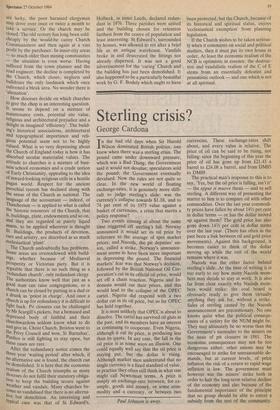Anglican MacGregors
Gavin Stamp
Holbeck, Leeds
Thanks to callous decisions taken on purely economic grounds by remote bureaucrats, communities all over the country are being impoverished, made to feel worthless and forgotten. Ordinary people are valued in crude monetarist terms rather than by any higher system, of values. The mentality of the accountant triumphs. I refer, of course, not so much to the closure of mines by the National Coal Board as to the closure of churches by the Church of England.
Bishops talk of the necessity of compas- sion, of the cruel inadequacy of applying purely economic criteria to human prob- lems, of the need to respect communities, yet the Church of England behaves with conspicuous ruthlessness when it comes to property and to money. Tradition, spiritual values and the importance of community life are seldom considered when the future of churches is discussed, only the cost of maintenance, heating bills and declining manpower. The result is the cold and calculating policy of declaring churches redundant, about which the bishops are remarkably unapologetic. Many parts of the inner cities — about which so many crocodile tears are shed — and large tracts of the countryside are now churchless and lack that visible symbol of tradition, con- tinuity and the importance of values other than the material represented by a building raised for the purpose of worshipping God. And few of our compassionate bishops could care less.
Those ruthless and cynical landlords, the Church Commissioners, are not alone to blame for this. Individual dioceses decide to declare churches redundant and some bishops seem to be working to fill quotas of their own for closures. Others, fortunately, do not: few churches have been closed in Carlisle or Truro. Elsewhere the picture is extremely depressing. Between 1968, when the Church of England established its Pastoral Measure for dealing with redun- dant churches, and the end of 1983, 1,043 have been closed. Of these 238 have been demolished, and 187, considered to be of exceptional architectural quality, have been vested in the Redundant Churches Fund. In certain areas, the whole visible pattern of worship has been devastated. In the Diocese of Wakefield, 12 out of 25 redundant churches have been pulled down; in Liverpool 16 out of 27. And many more are threatened.
In comparison, the policy of the NCB seems mild and gentle. In 1970 there were 292 collieries employing 287,00() men; to- day there are 174 employing 182,000. At present the NCB wishes to reduce produc- tion of 101 million tons a year by 4 million tons. It is hoped to reduce manpower by another 18,000 but the compensation offered is generous and no compulsory redundancies are threatened. Of course coal mines really cannot be compared with churches: mines are operated for material reasons whereas churches were built for and are still widely regarded as having a higher purpose. Clearly, however, the closure of a pit has wider implications than the purely econo- mic. It can leave a whole communitY rootless and crushed. But these mining 'communities' are often of recent origin and are depressingly monochrome socially and visually. Many other communities, that is, villages, have, in contrast, existed for centuries and now the Church of England is assisting their decline. Not only have the post office and the school closed, but now they have no vicar. Their church may be part of a team ministry and, if they are lucky, the poor harassed clergyman may drive over once or twice a month to take a service. Or the church may be closed. The old rectory has long been sold: cheaply by the would-be canny Church Commissioners and then again at a vast profit by the purchaser. In inner-city areas — so much older than mining communities — the situation is even worse. Having suffered from the town planner and the road engineer, the decline is completed by the Church, which closes, neglects and bulldozes the only landmark which once enlivened a bleak area. No wonder there is `alienation'.
How dioceses decide on which churches to give the chop is an interesting question. It seems to depend on a mixture of maintenance costs, potential site value, religious and architectural prejudice and a delight in imagined 'efficiency'. The build- ing's historical associations, architectural and topographical importance and reli- gious potential seem not to be highly valued. What is so very depressing about the Church of England today is how it has absorbed secular materialist values. The attitude to churches is a mixture of busi- ness school economics and a crude notion of Early Christianity, appealing to the idea of inward-looking religious cells in a hostile Pagan world. Respect for the ancient parochial system has declined along with the sense of the Church as national. The language of the accountant — indeed, of Thatcherism — is applied to what is called the 'historic resources' of the Church, that is, buildings, plate, endowments and so on, and they are regarded as purely liquid assets, to be applied wherever is thought fit. Buildings, the products of devotion, care and artistry, are described as so much ecclesiastical 'plant'. The Church undoubtedly has problems. Some areas are overendowed with build- ings, whether because of Mediaeval Prosperity or Victorian piety. But it is arguable that there is no such thing as a `redundant church', only redundant clergy. The authorities know well that just as a good man can raise congregations, so a Church can be closed by putting in a dud or a drunk as 'priest in charge'. And once a church is up for redundancy it is difficult to fight back. Pit closures can be challenged by Mr Scargill's pickets, but a bemused and depressed body of faithful and their churchwardens seldom know what to do and give in. Christ Church, Brixton went to the Privy Council and won, St Barnabas', Pimlico is still fighting to stay open, but these cases are rare.
After the redundancy notice comes the three year 'waiting period' after which, if no alternative use is found, the church can be demolished. It is here that the economic realism of the Church triumphs as many dioceses do not fulfil their statutory obliga- tion to keep the building secure against Weather and vandals. Many churches be- come so vandalised that there is no alterna- tive but demolition. An interesting and typical case was that of St Edward's, Holbeck, in inner Leeds, declared redun- dant in 1976. Three parishes were united and the building chosen for retention furthest from the centre of population and least interesting. St Edward's, surrounded by houses, was allowed to rot after a brief life as an antique warehouse. Vandals broke in and desecrated the fittings not already dispersed. It was not a good advertisement for the 'caring' Church and the building has just been demolished. It also happened to be a particularly beautiful work by G. F. Bodely which ought to have been protected, but the Church, because of its historical and spiritual status, enjoys `ecclesiastical exemption' from planning legislation.
If the Church wishes to be taken serious- ly when it comments on social and political matters, then it must put its own house in order, At least the economic realism of the NCB is optimistic in essence: the destruc- tive and vandalistic realism of the C of E stems from an essentially defeatist and pessimistic outlook — and one which is not at all spiritual.



















































 Previous page
Previous page